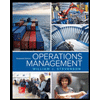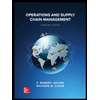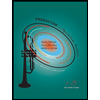A computer company that operates 250 days a year has an annual demand of 20,000. They want to determine EOQ for circuit boards which have an annual holding cost of $10/unit, and an ordering cost of $75. The purchasing lead time is 5 days. What is the reorder point (ROP) and Total Cost (TC)?
A computer company that operates 250 days a year has an annual demand of 20,000. They want to determine EOQ for circuit boards which have an annual holding cost of $10/unit, and an ordering cost of $75. The purchasing lead time is 5 days. What is the reorder point (ROP) and Total Cost (TC)?
Practical Management Science
6th Edition
ISBN:9781337406659
Author:WINSTON, Wayne L.
Publisher:WINSTON, Wayne L.
Chapter2: Introduction To Spreadsheet Modeling
Section: Chapter Questions
Problem 20P: Julie James is opening a lemonade stand. She believes the fixed cost per week of running the stand...
Related questions
Question
![### Understanding Economic Order Quantity and Reorder Point
A computer company that operates 250 days a year has an annual demand of 20,000 units for circuit boards. They are seeking to determine the Economic Order Quantity (EOQ), with the following additional information:
- **Annual Holding Cost:** $10 per unit
- **Ordering Cost:** $75 per order
- **Purchasing Lead Time:** 5 days
**Objective:**
Calculate the Reorder Point (ROP) and Total Cost (TC).
**Options:**
- **Option 1:** 400 units, $5,477
- **Option 2:** 300 units, $3,000
- **Option 3:** 400 units, $5,350
- **Option 4:** 200 units, $2,000
- **Option 5:** 350 units, $5,277
### Explanation of the Concepts:
- **Economic Order Quantity (EOQ):** A calculation used to determine the optimal order quantity that minimizes the total inventory cost, including ordering and holding costs.
- **Reorder Point (ROP):** The inventory level at which a new order should be placed to avoid stockouts, taking the lead time into account.
### Steps for Calculation:
1. **EOQ Formula:**
\[
EOQ = \sqrt{\left(\frac{2 \times \text{Demand} \times \text{Ordering Cost}}{\text{Holding Cost}}\right)}
\]
2. **Reorder Point Calculation:**
\[
ROP = \text{Daily Demand} \times \text{Lead Time}
\]
- Daily Demand = \(\frac{\text{Annual Demand}}{\text{Operating Days}}\)
3. **Total Cost (TC):**
\[
TC = \left(\frac{\text{Demand} \times \text{Ordering Cost}}{EOQ}\right) + \left(\frac{EOQ \times \text{Holding Cost}}{2}\right)
\]
These calculations help the company maintain an efficient inventory system, reducing costs and ensuring adequate supply.
### Note:
Given options suggest varying units for EOQ, and the accompanying total costs. Select the correct pairing based on computed EOQ and ROP values.](/v2/_next/image?url=https%3A%2F%2Fcontent.bartleby.com%2Fqna-images%2Fquestion%2F537cca7c-787a-475d-9aba-926e9a602de3%2F1a14be5f-d3b2-48cf-b59f-6d73c6ee35ae%2F7s8p4ht_processed.jpeg&w=3840&q=75)
Transcribed Image Text:### Understanding Economic Order Quantity and Reorder Point
A computer company that operates 250 days a year has an annual demand of 20,000 units for circuit boards. They are seeking to determine the Economic Order Quantity (EOQ), with the following additional information:
- **Annual Holding Cost:** $10 per unit
- **Ordering Cost:** $75 per order
- **Purchasing Lead Time:** 5 days
**Objective:**
Calculate the Reorder Point (ROP) and Total Cost (TC).
**Options:**
- **Option 1:** 400 units, $5,477
- **Option 2:** 300 units, $3,000
- **Option 3:** 400 units, $5,350
- **Option 4:** 200 units, $2,000
- **Option 5:** 350 units, $5,277
### Explanation of the Concepts:
- **Economic Order Quantity (EOQ):** A calculation used to determine the optimal order quantity that minimizes the total inventory cost, including ordering and holding costs.
- **Reorder Point (ROP):** The inventory level at which a new order should be placed to avoid stockouts, taking the lead time into account.
### Steps for Calculation:
1. **EOQ Formula:**
\[
EOQ = \sqrt{\left(\frac{2 \times \text{Demand} \times \text{Ordering Cost}}{\text{Holding Cost}}\right)}
\]
2. **Reorder Point Calculation:**
\[
ROP = \text{Daily Demand} \times \text{Lead Time}
\]
- Daily Demand = \(\frac{\text{Annual Demand}}{\text{Operating Days}}\)
3. **Total Cost (TC):**
\[
TC = \left(\frac{\text{Demand} \times \text{Ordering Cost}}{EOQ}\right) + \left(\frac{EOQ \times \text{Holding Cost}}{2}\right)
\]
These calculations help the company maintain an efficient inventory system, reducing costs and ensuring adequate supply.
### Note:
Given options suggest varying units for EOQ, and the accompanying total costs. Select the correct pairing based on computed EOQ and ROP values.
Expert Solution
This question has been solved!
Explore an expertly crafted, step-by-step solution for a thorough understanding of key concepts.
This is a popular solution!
Trending now
This is a popular solution!
Step by step
Solved in 2 steps with 1 images

Recommended textbooks for you

Practical Management Science
Operations Management
ISBN:
9781337406659
Author:
WINSTON, Wayne L.
Publisher:
Cengage,

Operations Management
Operations Management
ISBN:
9781259667473
Author:
William J Stevenson
Publisher:
McGraw-Hill Education

Operations and Supply Chain Management (Mcgraw-hi…
Operations Management
ISBN:
9781259666100
Author:
F. Robert Jacobs, Richard B Chase
Publisher:
McGraw-Hill Education

Practical Management Science
Operations Management
ISBN:
9781337406659
Author:
WINSTON, Wayne L.
Publisher:
Cengage,

Operations Management
Operations Management
ISBN:
9781259667473
Author:
William J Stevenson
Publisher:
McGraw-Hill Education

Operations and Supply Chain Management (Mcgraw-hi…
Operations Management
ISBN:
9781259666100
Author:
F. Robert Jacobs, Richard B Chase
Publisher:
McGraw-Hill Education


Purchasing and Supply Chain Management
Operations Management
ISBN:
9781285869681
Author:
Robert M. Monczka, Robert B. Handfield, Larry C. Giunipero, James L. Patterson
Publisher:
Cengage Learning

Production and Operations Analysis, Seventh Editi…
Operations Management
ISBN:
9781478623069
Author:
Steven Nahmias, Tava Lennon Olsen
Publisher:
Waveland Press, Inc.